and who work to protect biodiversity hotspots around the world, by the Critical Ecosystem Partnership Fund (CEPF) in 2020.
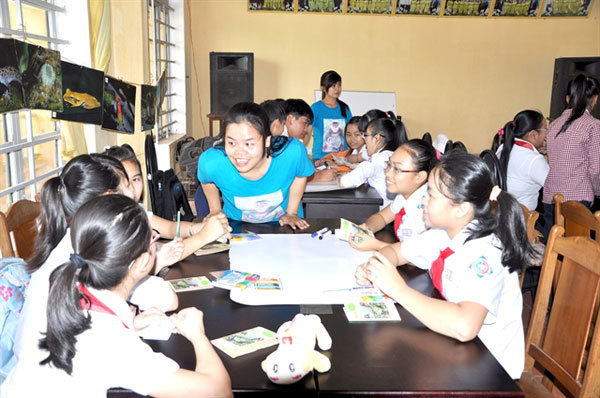 |
| Le Thi Trang joins a communication session on the protection of the endangered primates and forest at a primary school in Da Nang City. Photo courtesy of GreenViet |
Trang is the first conservationist in Da Nang to be so honoured and secured a place in the top ten due to her endless love of nature and, especially, her work in saving Vietnam’s largest population of endangered red-shanked douc langurs (Pygathrix nemaeus), at the Son Tra Nature Reserve in the central city.
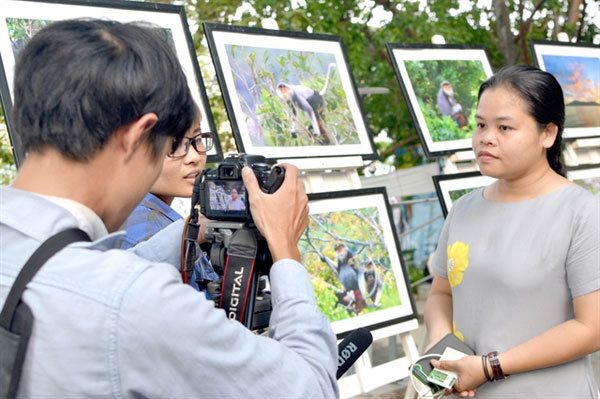 |
| Le Thi Trang from an NGO, GreenViet, presents at an exhibition on the endangered red-shanked douc langurs (Pygathrix nemaeus) in the Son Tra Nature Reserve, Da Nang City. Photo courtesy of GreenViet |
Trang, who is Vice Director of the Centre of Biodiversity Conservation and the NGO GreenViet, and her colleagues have been involved in community communications campaigns on wildlife protection, and especially the protection of the endangered red-shanked douc langurs in Son Tra, for the last ten years, promoting the responsibility all local residents must take in conservation.
“It is a great honour for myself and my GreenViet teammates and recognises our concerted efforts to raise awareness,” she said. “Many now know about the langurs at Son Tra, which is not at all far from the city centre.”
Love of wildlife
Born in 1986, Le Thi Trang, aka “King Kong”, nurtured her love of nature by undertaking environmental studies at the Da Nang College for Technology and Science and volunteering for ENV, where she monitored wildlife trafficking and trade in the central and central highlands region during her third year.
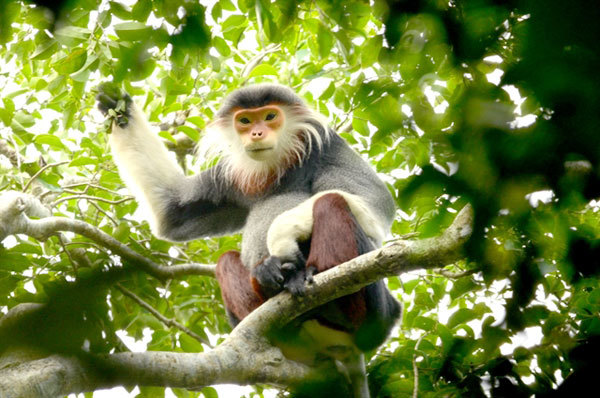 |
| A red-shanked douc langur (Pygathrix nemaeus) is taken by photographers at a close range shot in the Son Tra Nature Reserve of Da Nang. The reserve is home to 1,300 individuals of the endangered primates that is only seen in Laos and Vietnam. Photo courtesy of GreenViet |
She has helped local rangers counter numerous cases of wildlife trafficking and the illegal captivity of endangered species.
Trang joined GreenViet in 2013 and began boosting community communications as a long-term, sustainable measure to address the broader issue of wildlife protection.
“Given the rangers’ poor management skills and reluctance to enforce the law, raising awareness about the protection of endangered species is a key task and perfectly feasible,” she said.
“Only individual action can save wildlife from being killed by poachers. And only individuals can stop destroying forests and habitat.”
Ceaseless endeavour
A series of communication campaigns were organised in 2013-2017 to protect the endangered langurs at the nature reserve.
Kids and parents were encouraged to take field trips to Son Tra to watch the langurs, clean up the environment, plant trees, and set up the “Son Tra Little Guards” team, consisting solely of primary school students.
“Ten educational and communications programmes were organised every month in 2013-2017, with local primary school students attending eight sessions a week on nature and the endangered primates,” Trang recalled.
More than 300 teachers and 3,000 local residents joined around 25,000 primary school students in learning about nature and the langurs at Son Tra while on field trips.
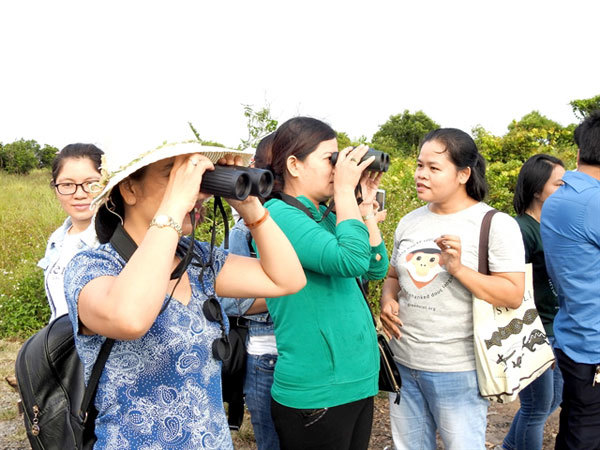 |
| Teachers from primary schools in Da Nang join a field trip for watching the endangered red-shanked douc langurs in the Son Tra Nature Reserve. It's a regular activity in raising awareness among community of the role and responsibility in protecting the nature and wildlife. Photo courtesy GreenViet |
The “I Love Son Tra” communications campaign inspired 13,000 people to support the protection of the Son Tra Nature Reserve and the langurs, with a total of VND1 billion (US$43,000) raised from donors last year for protection efforts.
“Eighty per cent of people who visited the reserve on field trips then supported the protection of the langurs and also protested mass tourism and over-construction on the reserve,” Trang said.
Great ambition
GreenViet, she explained, plans to educate 5,000 students from 56 schools in Da Nang on nature and wildlife protection over the next three years.
The younger generation in Da Nang will know the value and role of the langurs in the natural world and the need to maintain the “evergreen” forests of Son Tra.
“We hope the nature reserve will become a giant outdoor school for young people in Da Nang, fostering their love of nature and creating a positive attitude towards environmental protection,” she said.
“One ‘nature school’ was built on a 30-ha eco-tour site in the reserve and is a starting point for field trips of primary school students, parents, teachers, and tourists exploring the beauty of the primeval forest.”
In January of next year Trang will be the sole Vietnamese conservationist honoured at a special CEPF event in Paris.
This will be her second honour, following the 2015 Future for Nature Awards for young conservationist around the world.
“Trang was at the centre of the Son Tra campaign, bringing dynamism, creativity, and inexhaustible energy,” said Managing Director of CEPF Jack Tordoff, who oversees CEPF investment in the Indo-Burma Biodiversity Hotspot, which includes Vietnam. “Her work and that of GreenViet inspire me.”
“The ‘Hotspot Heroes’ represent the many tenacious, committed conservationists taking action every day to ensure the future of biodiversity hotspots and the people who depend on these vital ecosystems,” CEPF Executive Director Olivier Langrand added.
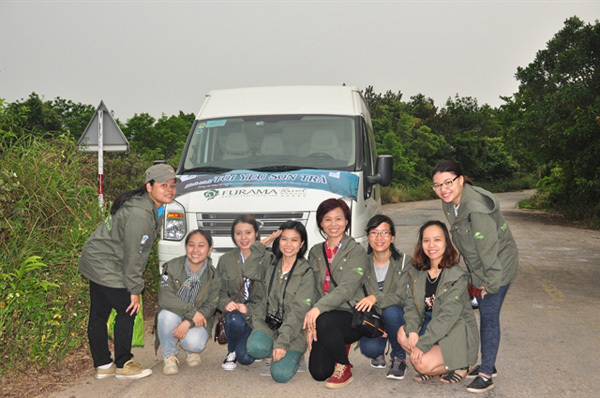 |
| Conservationists and communication staffs of GreenViet take part in a field trip in the Son Tra Nature reserve in tracking the endangered primates in the area. Photo courtesy of GreenViet |
“Trang and GreenViet endure a multitude of challenges - long hours, gruelling travel, difficult working conditions, political hurdles, and even threats to their lives - in pursuit of a healthy, sustainable world,” he went on.
“They are changing the way people in Vietnam value nature, bringing together communities, businesses, and government to protect important ecosystems that are key to the country’s future.”
According to a recent GreenViet report, the 4,400-ha Son Tra Nature Reserve is home to more than 1,300 red-shanked douc langurs and in excess of 1,000 plant and 370 animal species.
The red-shanked douc langur was featured in the biodiversity logo of the Da Nang Department of Natural Resources and Environment in 2017. VNS
Cong Thanh

Vietnamese conservationist honored as biodiversity ‘Hotspot Hero’
The Critical Ecosystem Partnership Fund (CEPF) announced that Le Thi Trang and nine other conservationists from around the world have been named ‘Hotspot Heroes’ for their efforts to protect the world’s biodiversity hotspots.
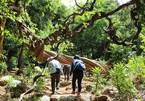
Sustainable protection needed for Son Tra Reserve
Human activities in the Son Tra Nature Reserve had changed the basic instincts of langurs and monkeys, while threatening the primate population with human-to-wildlife transmitted diseases, according to biologist Tran Huu Vy.
 Having initially begun her involvement in wildlife protection as a volunteer with Education for Nature - Vietnam (ENV) in 2007, 34-year-old Le Thi Trang from Da Nang was named among the world’s top ten conservationists, called “Hotspot Heroes”" itemprop="description" />
Having initially begun her involvement in wildlife protection as a volunteer with Education for Nature - Vietnam (ENV) in 2007, 34-year-old Le Thi Trang from Da Nang was named among the world’s top ten conservationists, called “Hotspot Heroes”" itemprop="description" />